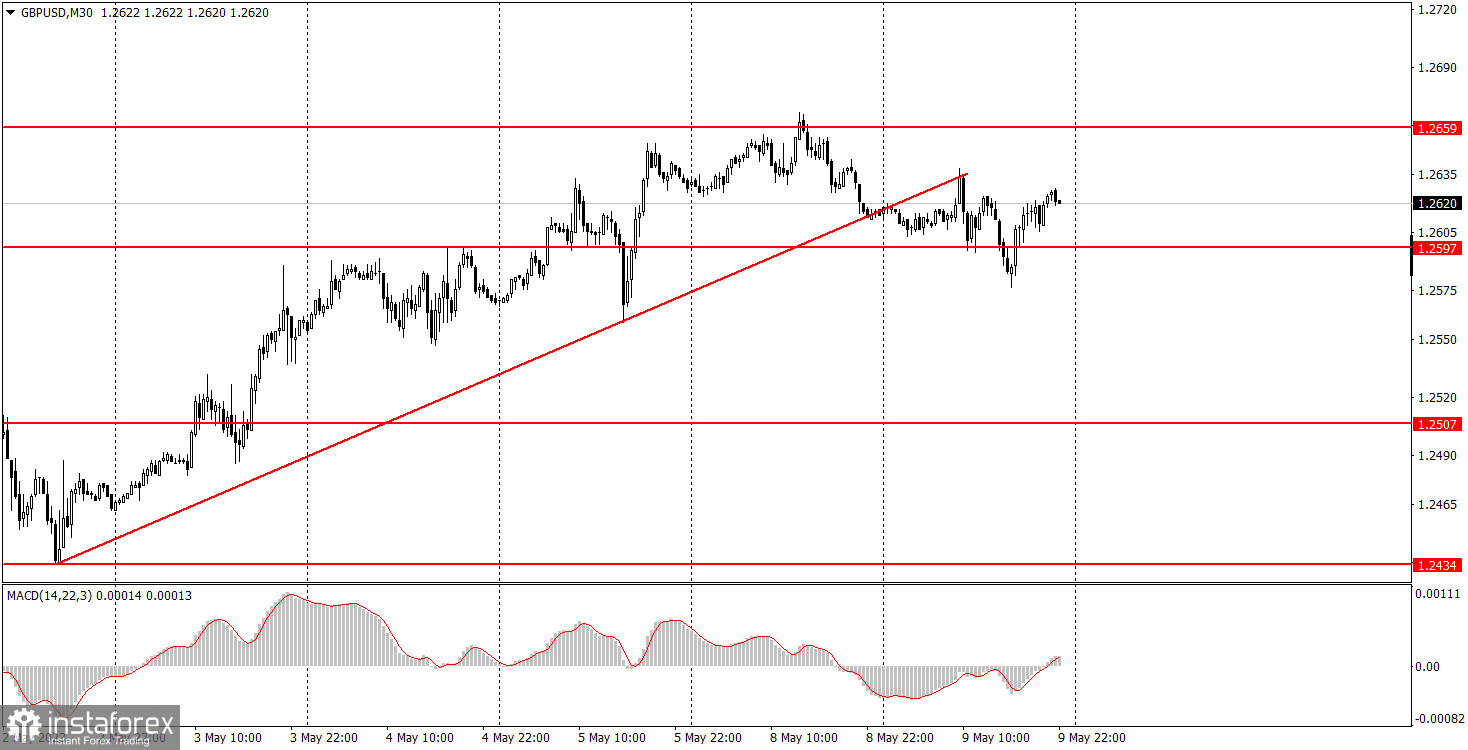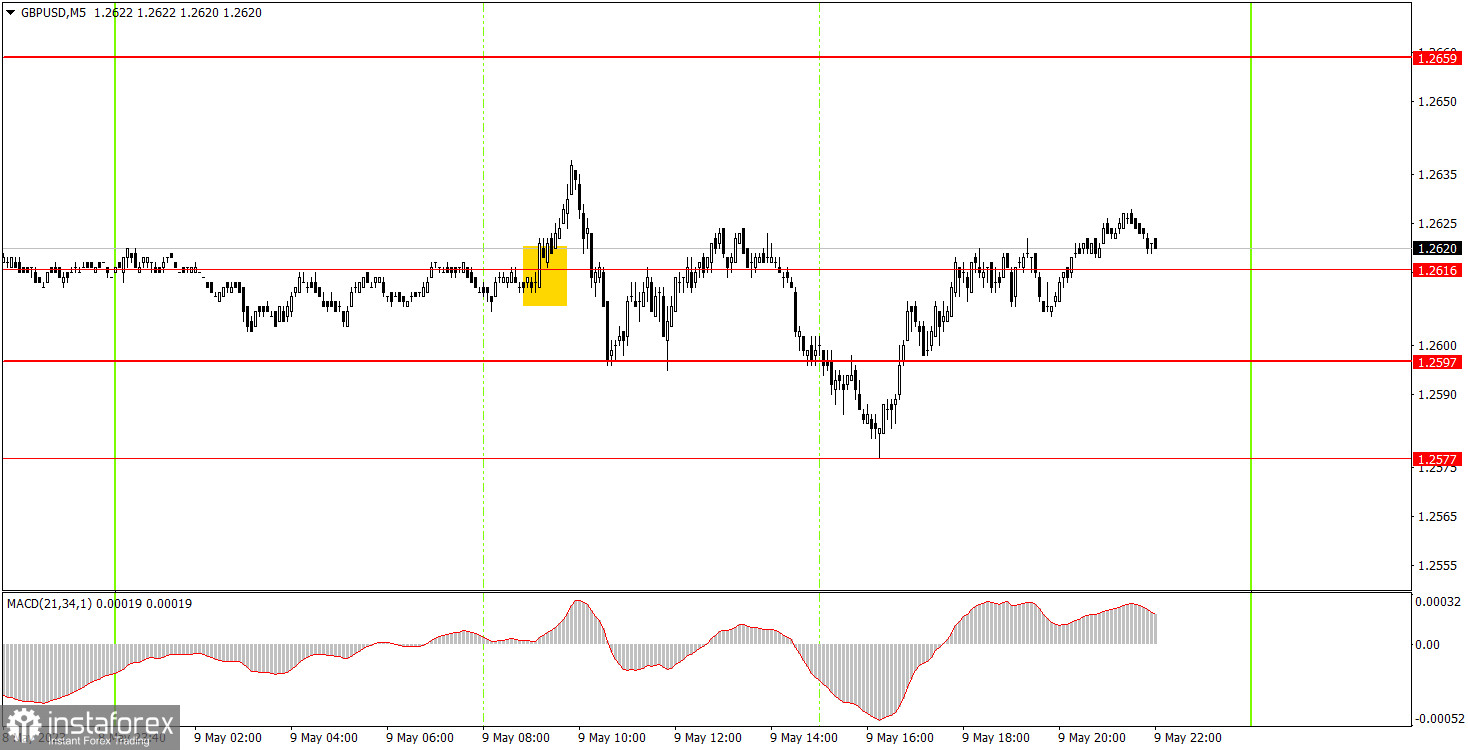Analyzing Tuesday's trades:
GBP/USD on 30M chart

The GBP/USD pair tried to continue its downward movement and even overcame the ascending trend line. However, we remember that overcoming the last 4 trend lines did not even lead to a decline in the British currency. Therefore, this breakthrough may cause a slight correction, but then afterwards the growth will resume. Moreover, the Bank of England will announce the results of its meeting on Thursday and is likely to raise the key rate by another 0.25%. Despite the fact that the market had plenty of time to work out this decision "in advance," the pound may still resume growth, as the market is currently using any opportunity to buy the British currency.
Nevertheless, we should still expect a decline in quotes. The pound is also very overbought, and the US inflation report could theoretically help the dollar if it turns out to be weak. But then also remember that the market has been trading very illogically lately, so the pair may decline at any inflation report value. At some point, traders may simply say to themselves, "stop, enough!" and start taking profits on long positions. Then, regardless of the fundamental and macroeconomic backgrounds, the pair will trade lower. And such a development of events would be quite fair.
GBP/USD on 5M chart

Trading signals on the 5-minute chart left much to be desired. It is not surprising that volatility was low, and the price spent most of the day in the 1.2577-1.2597-1.2616 area. There was no point in trading between these levels, so the only signal that beginners could try to work out was a bounce from the 1.2616 level. But even this should not have been done, as the level of potential loss far exceeded the level of potential profit. The Stop Loss for the trade would have to be placed below the 1.2577 level, and with the current volatility, there was no hope for strong growth. Therefore, the correct decision was not to open positions on Tuesday.
Trading tips on Wednesday:
On the 30-minute chart, GBP/USD continues to trade higher in the medium term, or at least it doesn't fall, which is clearly visible on the 4-hour chart, as well as on higher ones. The movements are mostly illogical, as does the market's reaction to fundamental and macroeconomic events, which Friday proved once again. Overcoming another ascending trend line does not mean anything right now. On the 5-minute chart, you can trade at levels 1.2466-1.2477, 1.2507-1.2520, 1.2577-1.2597-1.2616, 1.2659-1.2674, 1.2697, 1.2772, 1.2860. As soon as the price passes 20 pips in the right direction, you should set a Stop Loss to breakeven. There are absolutely no interesting events planned in the UK on Wednesday, but an important inflation report will be published in the US. If its value is neutral, we will not see a reaction. You can expect the pound to fall, but not too much.
Basic rules of the trading system:
1) The strength of the signal is determined by the time it took the signal to form (a rebound or a breakout of the level). The quicker it is formed, the stronger the signal is.
2) If two or more positions were opened near a certain level based on a false signal (which did not trigger a Take Profit or test the nearest target level), then all subsequent signals at this level should be ignored.
3) When trading flat, a pair can form multiple false signals or not form them at all. In any case, it is better to stop trading at the first sign of a flat movement.
4) Trades should be opened in the period between the start of the European session and the middle of the US trading hours when all positions must be closed manually.
5) You can trade using signals from the MACD indicator on the 30-minute time frame only amid strong volatility and a clear trend that should be confirmed by a trendline or a trend channel.
6) If two levels are located too close to each other (from 5 to 15 pips), they should be considered support and resistance levels.
On the chart:
Support and Resistance levels are the levels that serve as targets when buying or selling the pair. You can place Take Profit near these levels.
Red lines are channels or trend lines that display the current trend and show in which direction it is better to trade now.
The MACD indicator (14, 22, and 3) consists of a histogram and a signal line. When they cross, this is a signal to enter the market. It is recommended to use this indicator in combination with trend patterns (channels and trendlines).
Important announcements and economic reports that can be found on the economic calendar can seriously influence the trajectory of a currency pair. Therefore, at the time of their release, we recommend trading as carefully as possible or exiting the market in order to avoid sharp price fluctuations.
Beginners on Forex should remember that not every single trade has to be profitable. The development of a clear strategy and money management is the key to success in trading over a long period of time.
 English
English 
 Русский
Русский Bahasa Indonesia
Bahasa Indonesia Bahasa Malay
Bahasa Malay ไทย
ไทย Español
Español Deutsch
Deutsch Български
Български Français
Français Tiếng Việt
Tiếng Việt 中文
中文 বাংলা
বাংলা हिन्दी
हिन्दी Čeština
Čeština Українська
Українська Română
Română

